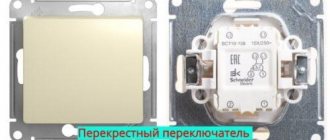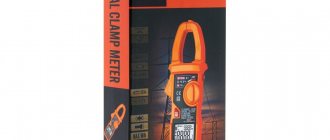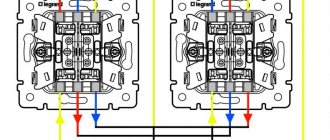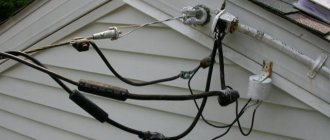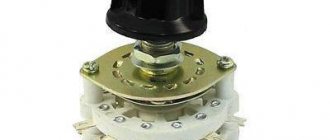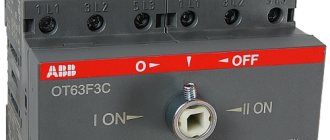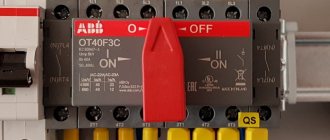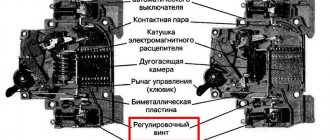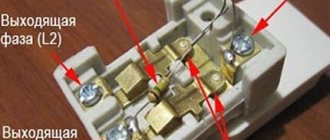Updated: 04/23/2021 12:51:22
Expert: Konstantin Borisovich Polyakov
During the first or major renovation of an apartment, you want to do everything “once and for all.” Especially - laying wiring in the walls. Because if you make even one, even an insignificant mistake, you will have to tear off the wallpaper and re-drill the plaster.
The problem is that we all want comfort. An apartment should be a place not just to sleep, but to fully relax, where everything is at hand. After all, it would be stupid to pay millions of rubles for inconvenience, wouldn’t it?
And now dual-circuit lighting systems are especially popular. This is not only a design, but also a completely operational solution. When you want a pleasant, dim light, one circuit turns on. But if you need something brighter, you can turn on a second circuit with higher power lamps. Also, such a lighting system helps with zoning, which is especially important for studio apartments.
Also, sometimes there is a need to create two-point lighting systems. For example, if you want to turn on the lamps at the beginning of the corridor, and turn them off at the end.
Switches are used to control dual-circuit or two-point lighting systems. They are comfortable and practical. But are they worth the money? In this article we will look at how a power switch differs from a switch, and in which cases it is better to use one or another device.
Main advantages
Electric switch
It is impossible to distinguish the devices by appearance, but the operating principle is different. In some rooms it is inconvenient to use the switch (for example, in long corridors). The main advantages of switches are:
- the ability to connect several electrical networks to each other;
- the device allows you to control (turn on, switch, turn off) a branched electrical circuit from one point;
- one light source can be activated from different places in the room (for example, turn on the chandelier in the guest room from the corridor).
In fact, the device is constantly in working condition - this is one of the main differences between a switch and a switch. With the help of changeover contacts, additional electrical circuits are created in the network.
Practical recommendations for use
Using the switch requires compliance with the following rules:
- The device is operated at temperatures from -40 to +50 degrees.
- The reversing switch is installed only in a panel with a mounting panel.
- It is allowed to manually activate circuit breakers with arcing and breaking contacts.
- The burnt contact blade is cleaned with a file or glass paper.
- To prevent the legs from skewing, tighten the mounting bolts tightly.
- All active parts of the device are isolated.
- For manual phase transfer, a transition switch operating in two directions is suitable.
- You need to select a switch according to the power of the current passed.
Changeover switches are suitable for installation in apartment buildings, in production with backup generators. The devices simplify the maintenance of power supplies, monitor power lines and protect the equipment connected to it.
Operating principle
The principle of operation of a switch
To understand what a switch is, you need to consider the principle of its operation and purpose. The device serves to redirect the flow of electricity to another circuit - one circuit is disconnected and the other is closed at the same time. Therefore, the minimum number of contacts for such a device is three. For mechanisms with two or more “keys” the number doubles.
A switch is a switch between electrical conductors of reverse voltage. Purpose – control of one light source from different places. Mainly used for premises with a large area, for example, stadiums, production workshops or warehouses.
Installation of a three-point switching system
To do this you need to do the following:
- Draw a wiring diagram.
- Mark and drill grooves and recesses for wiring and boxes.
- Install distribution parts. They are selected in large sizes so that 12 connections can be made inside.
- Install socket boxes.
- Lay the cable from the panel to the connection points.
- Connect the wires to the switches and terminals in the boxes. Label the wires. Assemble the circuit sequentially, checking the correct connections.
- Place the switches in their places.
Types of devices
Rotary switch
There are several switch options. To select the optimal one, you should take into account the type of problem being solved, the required method of controlling the mechanism, and the parameters of the existing electrical circuit.
By controlling and moving the toggle switch, the following types are distinguished:
- corner (with internal contacts or rocker arms);
- push;
- rotary.
Angular devices of both types differ in the ability of the toggle switch to be in two fixed positions. Shifting the handle allows you to move the moving contact from one circuit to another. The movement of direct and alternating currents is redirected.
For toggle switches, different connection schemes are used. There are no restrictions; the final option depends on the needs of the room and the imagination of the electrician.
Switch with two keys
Maximum load - 6 Amperes. In this case, a small level of resistance is observed (no more than 0.02 Ohm). The reliability of such equipment is determined by the number of possible switchings (the average number is 10,000 times).
Additional classification – by keys. There are three main types:
- with one button;
- with two;
- with three.
More keys are acceptable, but not safe. Each has three contacts. If there are too many “jumpers”, a short circuit and burnout of the circuit is inevitable.
According to their internal structure, switches are:
- classic (pass-through);
- intermediate (cross);
- combined.
The difference between the pass-through and cross-switch is the number of working electrodes. In the first case there are three contacts, in the second there are two each for the input and output of the electrical circuit. Intermediate ones are used to control several light sources, rather than just one.
What are the similarities
Despite serious differences, these devices have many common features. Among them, the main ones should be indicated:
- They are designed to control lighting and electrical devices.
- These products have several types. They can be installed indoors and outdoors.
- There are models with waterproof housings. They are intended for outdoor installation, as they are adapted to various weather conditions.
Thus, the switch has a more complex design and more useful features than a switch. At the same time, they are not inferior to switches in durability and design.
Electronics and technologyComment
Household use
Using a switch in stairwells
Installing or rewiring electrical wiring is all about functionality and ease of use. Therefore, before installation, a plan is drawn up, which specifies the total number of light bulbs, switches and sockets. Adapter devices are suitable for connection in the following situations:
- multi-level buildings - switches will allow you to turn off the lights on any floor;
- long corridors - you can turn on the lamps at the beginning and turn them off at the end;
- bedrooms - if you install one mechanism at the entrance, and the second near the bed, you will not need to get up to turn off the main light.
Use transition devices in all similar situations. This is especially true in large offices, hotels and other similar buildings.
Real examples
The devices in question are produced by many companies. Each of the products has its own characteristics.
The difference between a single-key
The main difference between the products under consideration is the number of keys. One of the most popular and sought-after devices is a single-key switch. Its main feature is the presence of 3 contacts in the structure.
Difference between switch and Legrand switch
Legrand is a leading manufacturer of electrical products. It offers expensive designer lines - Celiane, Galea Life, as well as popular high-quality budget models. These include Valena, Etika. The products of each series are produced and assembled in Hungary, Portugal and France.
The most popular line among Legrand products is the Valena series. The products of this brand are characterized by an optimal ratio of cost and quality. An affordable price is typical for the Etika series. It is low cost because it involves the use of plastic calipers.
The Celiane and Galea Life series are considered expensive and prestigious. They combine unique quality, sophisticated design and appropriate price. In addition, the Celiane line includes touch dimmers and switches.
What is the difference between a switch and a Schneider switch?
Schneider Electric is another French company that also offers a wide range of products. Its products are produced in France, Portugal and India. The Glossa line from the mid-price segment includes inexpensive switches and sockets. They have a classic, universal design and are characterized by smooth lines.
The Sedna and Unica lines are a little more expensive, but offer a wide selection. Thus, the Unica series offers a wide color palette of frames for switches. The Odace line is considered the most expensive among the company's products. At the same time, it uses plastic calipers.
Re- or breaker
Difference between a pass-through switch and a switch
To make the final choice, you should develop an initial wiring plan or study an existing one. It is usually attached to the technical documentation of the apartment or building. Then you need to determine the longest sections or rooms (workshops, corridors), imagine possible situations based on personal preferences (such as in the bedroom).
If you need to control one light source from different sides, you should install a switch. Then select the type of device - pass-through and cross-over switch. The first allows you to turn off the lamp from two different points, the second - from three or more. To install the latter type and route the wires correctly, it is better to invite a professional electrician.
When connecting several switches at different points in an apartment or room, you should keep a wiring connection plan. Otherwise, if repairs or redevelopment are required, it will be difficult to install all contact options for sockets and other elements.
Can a switch be used as a switch
During use, different situations arise. For example, after purchasing an apartment, it turned out that the previous owners installed switches in several rooms, and now their functioning is no longer needed.
To redirect the action of the device, it is enough not to use the third contact, which diverts the flow of electricity in another direction. First of all, the complete circuit of the electrical network closed by this switch is determined. The non-essential contacts are then isolated. After this, the mechanism will stop redirecting the current and will begin to work like a regular switch.
Multi-position switches of modular type
The cam burst switch is the most common type of these devices, like other switches, it is used to control various types of electrical loads.
Cam switches
The scope of application of cam switches is quite extensive; here are some examples of their use:
- AC and DC control switchboards;
- emergency shutdown systems, automatic transfer of reserve, switching of operating modes of electric motors;
- control of transformer substations and lighting;
- equipment for substations (control of grounding switches, sectional switches, disconnectors, etc.);
- switching heating equipment modes (turning on, off, switching electric heating elements of the load);
- selection of operating mode of electric welding equipment, etc.
Cam switches consist of several packages (each responsible for switching one line) placed in one housing. The figure below shows the structure of such a package.
Cam Switch Package
Designations in the figure:
- a - fixed contacts (4 pcs.), to which wires are connected;
- b – a special protrusion “cam”, which allows you to hold and move the rod;
- c – group of movable contacts (there are two of them in this type);
- d – two guide grooves (allow the rod to make translational movements);
- e – two rods covered with an insulating shell;
- f – contacts (8 pcs.), usually made of an alloy containing silver;
- g – package;
- h – two threaded rods (fix the bag and the lid);
- I – rotor;
- J – four springs (return the rod to the closed position);
- k - shaft connecting the handle to the rotor;
- l – four screws for clamping cable wires.
Note that the batch switch (cam switch) can have several positions, including zero, that is, when the contacts are disconnected. The figure shows the state of the switch in the neutral position.
Schematic representation of the switch in the zero position
ABB switch in zero position mode
Note that all the main characteristics of the switches are indicated on the device case; the following are displayed there:
- switch type;
- rated current for which the switch is designed;
- switching diagram and table;
- protection class.
Below is a diagram and switching table shown on the housing of the SPAMEL rotation direction switch.
Scheme and switching table of the SPAMEL switch
Thanks to this table, you can clearly see in what position and which groups of contacts are connected.
Pass-through switch connection diagrams
The connection and layout of an electrical network with switches depends on several factors: the number of controlled light sources and controls, the need to install additional (intermediate) shutdown points, and others. For example, in a multi-storey building it is necessary to calculate the possibility of controlling light at all levels; the scheme will differ significantly from that needed for one room.
Connecting a pass-through switch in an apartment. Location on the walls
To work with switches in wiring, three-core cables are used. If others are installed (with a smaller number), to connect, you will have to ditch the walls and lay a new section of wiring, or consider other options for controlling light sources.
Connecting two pass-through switches
As a rule, on the latest models there is a connection diagram on the inside, which should be followed when closing the circuit. Two pass-through devices allow you to control one light source, up to several small bulbs of the same network, for example, in a corridor.
When installing, you should consider the type of switch - single-key or two-key. The latter consists of two single-key mechanisms in one box (used for convenience and space saving). For a six-pin switch, two three-wire wires are supplied.
When connecting, it is important to consider the number of contacts of the mechanism - three or six. In order for the circuits to close in the correct direction, it is necessary to carefully connect the electrodes and cable.
Connecting several parallel consumers
Pass-through multi-contact switches are used for multiple users working in parallel. A distinctive point is the connection to the phases. The terminals at the input from the distribution box must be connected to each other and connected to one single phase. If you connect different ones to one device, the entire electrical circuit will short out and burn out.
Intermediate control point
An additional control element is required to switch from several points - three or more. This is the difference between a pass-through switch and a cross-over switch - in this case, the latter are used.
The intermediate mechanism changes the direction of current in the circuit. The action depends on the position of the switch at the two ends of the wiring - which network is supplied with voltage from different sides.
The number of intermediate elements must not be even. Otherwise, the circuit will not switch - the direction of the current will return to its original direction.
For two switches per light source, a complex installation diagram is not required. The main feature is the presence of a three-core cable. Help is required to install intermediate elements and more devices. It is important to consider the permissible voltage of the circuit. If necessary, an additional wire is pulled from the shield and a separate junction box is installed.
How to connect
In Soviet times, the use of a three-position switch for power supply to apartment buildings was common and ubiquitous. Then they were installed in distribution boards. Nowadays, instead of such devices, automatic ones are more often used. If the owner prefers to use a three-position three-phase switch, it can be installed in front of the electricity meter leading to the switchboard so that the apartment network can be turned off completely if the need arises. Also, to enhance network protection from excess load or short-circuit incident, we can recommend the combined use of both devices.
Control of two lighting systems from three places
A two-key pass-through switch can be a cross switch. It is installed as a kit. That is, it also includes two two-key limit switches if you need to control the lighting from three points. It will have 4 inputs and 4 outputs.
Installation is carried out as follows:
- To install the circuit, a standard box with a diameter of 60 mm is not enough. Therefore, its size should be larger. Or you need to install 2-3 pieces in series. ordinary.
- There are 12 wire connections for connection. To do this, you will need to lay 4 three-core cables. Here you should correctly mark the cores. Two limit switches have 6 contacts each, and the cross switch has 8 contacts.
- A phase is connected to PV1. Then you need to make the necessary connections. On the back of the device there is a diagram of a two-key pass-through switch. It must be correctly combined with external connections.
- PV2 is connected from lamps.
- The four outputs of PV1 are connected to the inputs of the cross switch, and then its outputs are connected to the 4 inputs of PV2.
Conclusions website
- The switch has two contacts and serves to disconnect and connect an electrical circuit.
- The switch has three contacts and serves both to connect and disconnect an electrical circuit, and to create a new circuit.
The pass-through switch allows you to organize convenient control of the lighting system from two or three places at the same time. This is a very practical system for long rooms, corridors, staircases and other rooms in which it is inconvenient to return to one switch to turn the light off and on. Let's look at how to make a pass-through switch with your own hands and in what cases it is needed.
Let's look at how to properly organize the connection process. To do this, you will need special switches with three contacts. That's what they're called - walk-throughs. They allow you to turn the light on and off from several places.
Connection diagram of two points
This is very convenient if you live in your own home, have large rooms or long corridors.
Imagine - you need to walk a six-meter corridor at night. At the entrance you turn on the light, cross it, and at the exit you turn it off. The same can be done in the bedroom, turning off the lights in the bed, in the office and other rooms. Such a scheme will also help on the street for lighting paths, gazebos, areas, etc. It allows you to save effort, time and electricity. Of course, you can replace it with a motion sensor, but this is not always convenient, and in most cases it is not practical to spend money on purchasing one.
Installation of two-key switches for control from two places
The sequence of actions should be like this:
- A diagram is drawn up, without which it is difficult to make connections.
- Distribution boxes and socket boxes are installed.
- 2 lighting groups are installed.
- Three-core cables are laid based on connection to the 6 contacts of each switch and to the lamps.
- According to the drawn up diagram, the cable cores are connected in the junction box, to the lamp sockets and to the switches.
The two-key pass-through switch can be replaced with a circuit of four single-key switches. But it will be irrational. Since more junction boxes will be required and cable consumption will increase.
